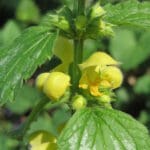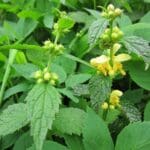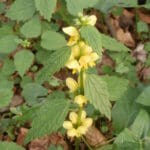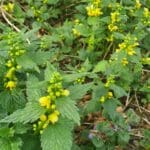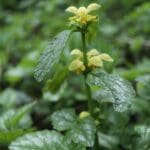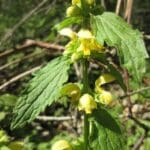Yellow Archangel / Spring / Summer / Edible
I always think the name Yellow Archangel sounds a little too sinister for this beautiful and edible wild plant.
Common Names
Yellow Archangel, Artillery plant, Aluminium plant, Yellow Weasel-snout, yellow dead-nettle
Botanical Name
Lamiastrum galeobdolon
Scientific Classification
Kingdom – Plantae
Order – Lamiales
Family – Lamiaceae
Physical Characteristics of Yellow Archangel
Erect, sparsely pubescent, stoloniferous (a horizontal stem above ground allowing propagation of clones of the mother plant), perennial, up to 60cm. Plants are either low and creeping when not in flower or upright when flowering.
Stem
Square in cross-section as with all member of the Mint family. These form long creeping leafy runners (stolons), especially after flowering.

Leaves
Leaves are stalked and 40-70mm long, oval, pointed, rounded at the base, stalked and coarsely toothed. They grow in opposite pairs up the stem with successive pairs at 90 degrees to previous pair, in a criss-cross pattern.
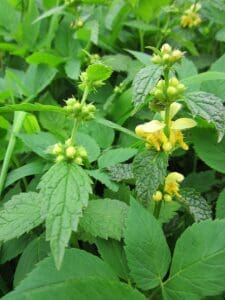
Flowers
Flowers are soft yellow and typical of the mint family, growing in whorls from the leaf axils, starting as tubes, dividing into upper hood and lower lip with red-brown streaks. Lower lip is three lobed. Flowers May to June.
Habitat
Widespread in England and Wales, naturalised in Scotland and Ireland.
Mostly found in woodlands on heavy, neutral, or calcareous soils. An indicator of ancient woodlands, it prefers damp shady places – mostly woodland but also found on hedge-banks.
Known Hazards
None known
Potential Lookalikes
This plant could be confused with a number of other Archangels – which all look pretty much identical apart from the colour of their flowers, their names are typically the colour of their flower followed by Archangel, as far as we’re aware all the others are edible also 🙂 These are also known as the Dead Nettles.
There is a silvery variegated cultivar of Yellow Archangel that is quite common in gardens, and being much more vigourous than the wild type can be a bit of an invasive nuisance.
Prior to flowering this could also be confused with the common Stinging Nettle, the main difference is the Stinging nettle won’t produce the yellow flowers of the archangel
Edible Uses
Use in a similar way to White and Red Dead Nettle – leaves and young stems in salads, steamed as a side vegetable or in a soup in place of Nettle.
Notes on Herbal uses
As with the other Dead Nettles they have been used in European folk medicine for centuries. The leaves and flowering tops are edible and are still used to make tisanes or infusions and decoctions as well as tinctures to relieve bladder paralysis and nephritis, as well as kidney problems.
Extra notes from the Foragers
Celtic communities viewed this plant as a protective barrier against evil spirits and a remedy for the affliction called ‘elf-shot’, which affected cattle. It was believed that elves, serving witches, would shoot arrows at cattle, causing paralysis. This condition was referred to as ‘elf stroke.’



